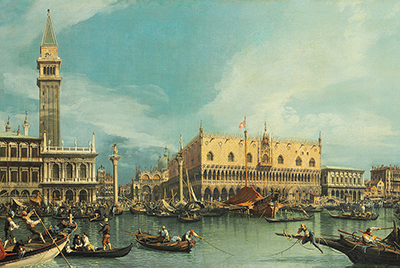The eighteenth-century Venetian painter Giovanni Antonio Canal, known as Canaletto, was an artist well-known for his scenes of Venice, though he also worked successfully within the cities of Rome and London as well.
One of his works was the painting titled The Molo, Seen from the Bacino di San Marco. The scene shows a view from the San Marco basin, facing the Doge's Palace and the heart of Venice. Canaletto painted The Molo, Seen from the Bacino di San Marco in the 1730s. The picture is an oil on canvas work that measures 68.8 x 112.7 cm. It's thought that the painting's original owner was Edward Howard, 9th Duke of Norfolk. In July 2013, an auction at Christies in London saw it sold for £8.6m to a private collector. The theme is one that Canaletto returned to on several occasions. A similar painting is on display in the Louvre in Paris and this artist's paintings are dispersed right across Europe today, with a few further afield in the US. His popularity today is perhaps even stronger than how he was regarded during his own lifetime, such is the accessible nature of his artistic style and the rise in popularity of landscape and cityscape art more generally.
The subject in Canaletto's painting of the Molo is not just the splendour of the Venetian buildings seen across the canal. By including boats and people in his picture, he shows the activity taking place on the quayside that is the Molo. In this specific version of the painting, Canaletto places three boats on the left of the picture. A barge is on the right. Looking at the boats, Canaletto captures a sense of energy and activity in the scene. One way that he does this is by showing the boatman in the first boat pulling back on the oar to avoid crashing into a gondola. A sailor on the barge is paying out a rope to the third boat that is just behind the gondola. Looking at the figures in the boats, Canaletto has applied great detail to both their clothing and the colours, leaving behind a charming depiction of life at that time that we today can step straight into. Such was the huge scale of these paintings that any viewer stood in front of such artworks can become engulfed in the scene, just as contemporary artists such as Mark Rothko would do many centuries later with their large murals.
As well as the boats on the canal, Canaletto displays some key buildings that define Venice. The view across the canal shows key buildings in the heart of Venice. In the picture, the bell tower is located on the left of the entrance to the Piazza di San Marco. On the right is the Doge's Palace. The Columns of Saint Mark and Saint Theodore stand at the entrance to the Piazza di San Marco. In front of them is the Molo. What the viewer sees in the painting is Canaletto's style of applying attention to detail. The result is that he offers the viewer a sense of realism in the picture and an ability to step back in time to an entirely different world. That said, it would be entirely wrong to consider Canaletto a member of the Realism movement, as not only did it appear well after his career, but he also did append his own imagination and emotions onto his creations. This makes him more similar to the Romanticist and Impressionists artists.




